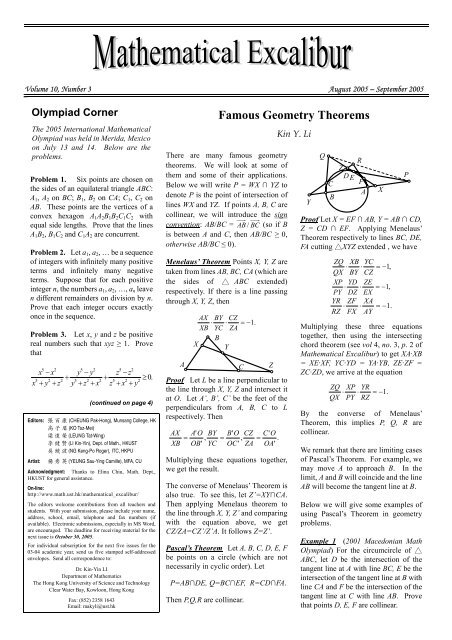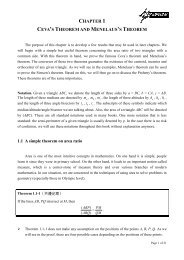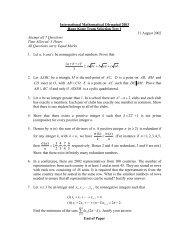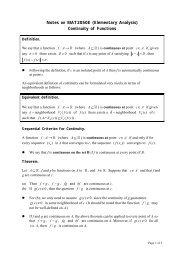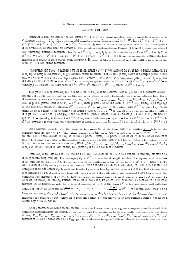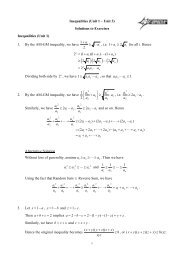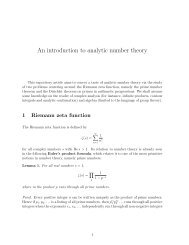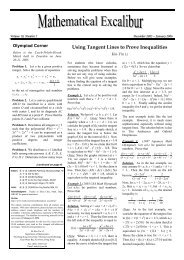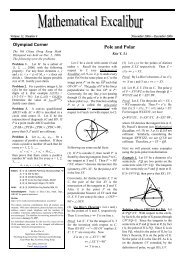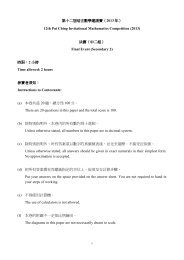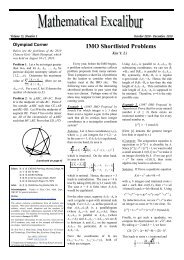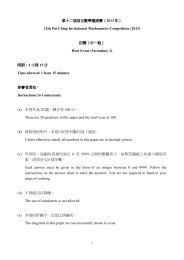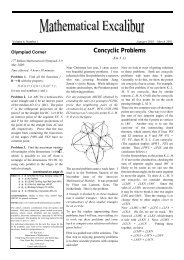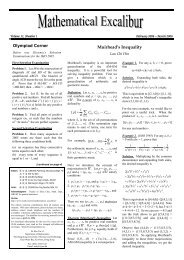Famous Geometry Theorems - Department of Mathematics - The ...
Famous Geometry Theorems - Department of Mathematics - The ...
Famous Geometry Theorems - Department of Mathematics - The ...
Create successful ePaper yourself
Turn your PDF publications into a flip-book with our unique Google optimized e-Paper software.
Volume 10, Number 3 August 2005 – September 2005<br />
Olympiad Corner<br />
<strong>The</strong> 2005 International Mathematical<br />
Olympiad was held in Merida, Mexico<br />
on July 13 and 14. Below are the<br />
problems.<br />
Problem 1. Six points are chosen on<br />
the sides <strong>of</strong> an equilateral triangle ABC:<br />
A 1, A 2 on BC; B 1, B 2 on CA; C 1, C 2 on<br />
AB. <strong>The</strong>se points are the vertices <strong>of</strong> a<br />
convex hexagon A1A2B1B2C1C 2 with<br />
equal side lengths. Prove that the lines<br />
A B , B C and C A are concurrent.<br />
1 2 1 2 1 2<br />
Problem 2. Let a 1 , a 2 , … be a sequence<br />
<strong>of</strong> integers with infinitely many positive<br />
terms and infinitely many negative<br />
terms. Suppose that for each positive<br />
integer n, the numbers a 1 , a 2 , …, a n leave<br />
n different remainders on division by n.<br />
Prove that each integer occurs exactly<br />
once in the sequence.<br />
Problem 3. Let x, y and z be positive<br />
real numbers such that xyz ≥ 1. Prove<br />
that<br />
5 2<br />
x − x<br />
5 2<br />
x + y + z<br />
2<br />
5 2<br />
y − y<br />
+<br />
5 2<br />
y + z + x<br />
2<br />
+<br />
z<br />
5<br />
5 2<br />
z − z<br />
2<br />
+ x + y<br />
2<br />
≥0.<br />
(continued on page 4)<br />
Editors: (CHEUNG Pak-Hong), Munsang College, HK<br />
(KO Tsz-Mei)<br />
(LEUNG Tat-Wing)<br />
(LI Kin-Yin), Dept. <strong>of</strong> Math., HKUST<br />
(NG Keng-Po Roger), ITC, HKPU<br />
Artist:<br />
(YEUNG Sau-Ying Camille), MFA, CU<br />
Acknowledgment: Thanks to Elina Chiu, Math. Dept.,<br />
HKUST for general assistance.<br />
On-line:<br />
http://www.math.ust.hk/mathematical_excalibur/<br />
<strong>The</strong> editors welcome contributions from all teachers and<br />
students. With your submission, please include your name,<br />
address, school, email, telephone and fax numbers (if<br />
available). Electronic submissions, especially in MS Word,<br />
are encouraged. <strong>The</strong> deadline for receiving material for the<br />
next issue is October 30, 2005.<br />
For individual subscription for the next five issues for the<br />
03-04 academic year, send us five stamped self-addressed<br />
envelopes. Send all correspondence to:<br />
Dr. Kin-Yin LI<br />
<strong>Department</strong> <strong>of</strong> <strong>Mathematics</strong><br />
<strong>The</strong> Hong Kong University <strong>of</strong> Science and Technology<br />
Clear Water Bay, Kowloon, Hong Kong<br />
Fax: (852) 2358 1643<br />
Email: makyli@ust.hk<br />
<strong>Famous</strong> <strong>Geometry</strong> <strong><strong>The</strong>orems</strong><br />
<strong>The</strong>re are many famous geometry<br />
theorems. We will look at some <strong>of</strong><br />
them and some <strong>of</strong> their applications.<br />
Below we will write P = WX ∩ YZ to<br />
denote P is the point <strong>of</strong> intersection <strong>of</strong><br />
lines WX and YZ. If points A, B, C are<br />
collinear, we will introduce the sign<br />
convention: AB/BC = AB / BC (so if B<br />
is between A and C, then AB/BC ≥ 0,<br />
otherwise AB/BC ≤ 0).<br />
Menelaus’ <strong>The</strong>orem Points X, Y, Z are<br />
taken from lines AB, BC, CA (which are<br />
the sides <strong>of</strong> △ ABC extended)<br />
respectively. If there is a line passing<br />
through X, Y, Z, then<br />
A<br />
X<br />
AX<br />
XB<br />
BY CZ<br />
⋅ = −1.<br />
YC ZA<br />
B<br />
Y<br />
⋅<br />
Pro<strong>of</strong> Let L be a line perpendicular to<br />
the line through X, Y, Z and intersect it<br />
at O. Let A’, B’, C’ be the feet <strong>of</strong> the<br />
perpendiculars from A, B, C to L<br />
respectively. <strong>The</strong>n<br />
AX<br />
XB<br />
A'<br />
O BY<br />
= ,<br />
OB'<br />
YC<br />
C<br />
Z<br />
B'<br />
O CZ C'<br />
O<br />
= , = .<br />
OC'<br />
ZA OA'<br />
Multiplying these equations together,<br />
we get the result.<br />
<strong>The</strong> converse <strong>of</strong> Menelaus’ <strong>The</strong>orem is<br />
also true. To see this, let Z’=XY∩CA.<br />
<strong>The</strong>n applying Menelaus theorem to<br />
the line through X, Y, Z’ and comparing<br />
with the equation above, we get<br />
CZ/ZA=CZ’/Z’A. It follows Z=Z’.<br />
Pascal’s <strong>The</strong>orem Let A, B, C, D, E, F<br />
be points on a circle (which are not<br />
necessarily in cyclic order). Let<br />
P=AB∩DE, Q=BC∩EF, R=CD∩FA.<br />
<strong>The</strong>n P,Q,R are collinear.<br />
Kin Y. Li<br />
Y<br />
Q<br />
C<br />
B<br />
R<br />
Z<br />
D E F<br />
A<br />
Pro<strong>of</strong> Let X = EF ∩ AB, Y = AB ∩ CD,<br />
Z = CD ∩ EF. Applying Menelaus’<br />
<strong>The</strong>orem respectively to lines BC, DE,<br />
FA cutting △XYZ extended , we have<br />
X<br />
ZQ XB YC<br />
⋅ ⋅ = −1,<br />
QX BY CZ<br />
XP YD ZE<br />
⋅ ⋅ = −1,<br />
PY DZ EX<br />
YR ZF XA<br />
⋅ ⋅ = −1.<br />
RZ FX AY<br />
Multiplying these three equations<br />
together, then using the intersecting<br />
chord theorem (see vol 4, no. 3, p. 2 <strong>of</strong><br />
Mathematical Excalibur) to get XA·XB<br />
= XE·XF, YC·YD = YA·YB, ZE·ZF =<br />
ZC·ZD, we arrive at the equation<br />
ZQ<br />
QX<br />
XP<br />
⋅ ⋅<br />
PY<br />
YR<br />
RZ<br />
= −1.<br />
By the converse <strong>of</strong> Menelaus’<br />
<strong>The</strong>orem, this implies P, Q, R are<br />
collinear.<br />
We remark that there are limiting cases<br />
<strong>of</strong> Pascal’s <strong>The</strong>orem. For example, we<br />
may move A to approach B. In the<br />
limit, A and B will coincide and the line<br />
AB will become the tangent line at B.<br />
Below we will give some examples <strong>of</strong><br />
using Pascal’s <strong>The</strong>orem in geometry<br />
problems.<br />
Example 1 (2001 Macedonian Math<br />
Olympiad) For the circumcircle <strong>of</strong> △<br />
ABC, let D be the intersection <strong>of</strong> the<br />
tangent line at A with line BC, E be the<br />
intersection <strong>of</strong> the tangent line at B with<br />
line CA and F be the intersection <strong>of</strong> the<br />
tangent line at C with line AB. Prove<br />
that points D, E, F are collinear.<br />
P
Mathematical Excalibur, Vol. 10, No. 3, Aug. 05- Sept. 05 Page 2<br />
Solution Applying Pascal’s <strong>The</strong>orem<br />
to A, A, B, B, C, C on the circumcircle,<br />
we easily get D, E, F are collinear.<br />
Example 2 Let D and E be the<br />
midpoints <strong>of</strong> the minor arcs AB and AC<br />
on the circumcircle <strong>of</strong> △ ABC,<br />
respectively. Let P be on the minor arc<br />
BC, Q = DP ∩ BA and R = PE ∩ AC.<br />
Prove that line QR passes through the<br />
incenter I <strong>of</strong> △ABC.<br />
B<br />
D<br />
Q<br />
P<br />
I<br />
Solution Since D is the midpoint <strong>of</strong><br />
arc AB, line CD bisects ∠ ACB.<br />
Similarly, line EB bisects ∠ABC. So I<br />
= CD ∩ EB. Applying Pascal’s<br />
<strong>The</strong>orem to C, D, P, E, B, A, we get I, Q,<br />
R are collinear.<br />
Newton’s <strong>The</strong>orem<br />
A<br />
R<br />
C<br />
E<br />
A circle is<br />
inscribed in a quadrilateral ABCD with<br />
sides AB, BC, CD, DA touch the circle<br />
at points E, F, G, H respectively. <strong>The</strong>n<br />
lines AC, EG, BD, FH are concurrent.<br />
X<br />
D<br />
G<br />
C<br />
H<br />
O<br />
Pro<strong>of</strong>. Let O = EG∩FH and X =<br />
EH∩FG. Since D is the intersection <strong>of</strong><br />
the tangent lines at G and at H to the<br />
circle, applying Pascal’s <strong>The</strong>orem to<br />
E,G,G,F,H,H, we get O, D, X are<br />
collinear. Similarly, applying Pascal’s<br />
<strong>The</strong>orem to E, E, H, F, F, G, we get B, X,<br />
O are collinear.<br />
<strong>The</strong>n B,O,D are collinear and so lines<br />
EG, BD, FH are concurrent at O.<br />
Similarly, we can also obtain lines AC,<br />
EG, FH are concurrent at O. <strong>The</strong>n<br />
Newton’s <strong>The</strong>orem follows.<br />
Example 3 (2001 Australian Math<br />
Olympiad) Let A, B, C, A’, B’, C’ be<br />
points on a circle such that AA’ is<br />
perpendicular to BC, BB’ is<br />
perpendicular to CA, CC’ is<br />
perpendicular to AB. Further, let D be<br />
a point on that circle and let DA’<br />
F<br />
A<br />
E<br />
B<br />
intersect BC in A’’, DB’ intersect CA in B’’,<br />
and DC’ intersect AB in C’’, all segments<br />
being extended where required. Prove<br />
that A’’, B’’, C’’ and the orthocenter <strong>of</strong><br />
triangle ABC are collinear.<br />
A<br />
C'<br />
B''<br />
D<br />
B'<br />
H<br />
B<br />
A''<br />
C<br />
A'<br />
C''<br />
Solution Let H be the orthocenter <strong>of</strong> △<br />
ABC. Applying Pascal’s theorem to A, A’,<br />
D, C’, C, B, we see H, A’’, C’’ are collinear.<br />
Similarly, applying Pascal’s theorem to B’,<br />
D, C’, C, A, B, we see B’’, C’’, H are<br />
collinear. So A’’, B’’, C’’, H are collinear.<br />
Example 4 (1991 IMO unused problem)<br />
Let ABC be any triangle and P any point in<br />
its interior. Let P 1 , P 2 be the feet <strong>of</strong> the<br />
perpendiculars from P to the two sides AC<br />
and BC. Draw AP and BP and from C drop<br />
perpendiculars to AP and BP. Let Q 1 and<br />
Q 2 be the feet <strong>of</strong> these perpendiculars. If<br />
Q 2 ≠P 1 and Q 1 ≠P 2 , then prove that the lines<br />
P 1 Q 2 , Q 1 P 2 and AB are concurrent.<br />
A<br />
C<br />
P 1 P 2<br />
Q 2<br />
Q 1<br />
Solution Since ∠ CP 1 P, ∠ CP 2 P, ∠<br />
CQ 2 P, ∠CQ 1 P are all right angles, we see<br />
that the points C, Q 1 , P 1 , P, P 2 , Q 2 lie on a<br />
circle with CP as diameter. Note A = CP 1<br />
∩ PQ 1 and B = Q 2 P ∩ P 2 C. Applying<br />
Pascal’s theorem to C, P 1 , Q 2 , P, Q 1 , P 2 ,<br />
we see X = P 1 Q 2 ∩ Q 1 P 2 is on line AB.<br />
Desargues’ <strong>The</strong>orem For △ABC and △<br />
A’B’C’, if lines AA’, BB’, CC’ concur at a<br />
point O, then points P, Q, R are collinear,<br />
where P = BC ∩ B’C’, Q = CA ∩ C’A’, R<br />
= AB ∩ A’B’.<br />
Q<br />
A'<br />
A<br />
C<br />
C'<br />
O<br />
Pro<strong>of</strong> Applying Menelaus’ <strong>The</strong>orem<br />
respectively to line A’B’ cutting △OAB<br />
extended, line B’C’ cutting △ OBC<br />
extended and the line C’A’ cutting △OCA<br />
extended, we have<br />
P<br />
B<br />
P<br />
B'<br />
R<br />
B<br />
OA'<br />
⋅<br />
A'<br />
A<br />
OB'<br />
⋅<br />
B'<br />
B<br />
AR<br />
RB<br />
BP<br />
PC<br />
BB'<br />
⋅ = −1,<br />
B'<br />
O<br />
CC'<br />
⋅ = −1,<br />
C'<br />
O<br />
AA ' OC'<br />
CQ<br />
⋅ ⋅ = −1.<br />
A'<br />
O C'<br />
C QA<br />
Multiplying these three equations,<br />
AR<br />
RB<br />
⋅<br />
BP CQ<br />
⋅ = −1.<br />
PC QA<br />
By the converse <strong>of</strong> Menelaus’ <strong>The</strong>orem,<br />
this implies P, Q, R are collinear.<br />
We remark that the converse <strong>of</strong><br />
Desargues’ <strong>The</strong>orem is also true. We<br />
can prove it as follow: let O = BB’ ∩<br />
CC’. Consider △RBB’ and △QCC’.<br />
Since lines RQ, BC, B’C’ concur at P,<br />
and A = RB ∩ QC, O = BB’ ∩ CC’, A’<br />
= BR’ ∩ C’Q, by Desargues’ <strong>The</strong>orem,<br />
we have A,O,A’ are collinear.<br />
<strong>The</strong>refore, lines AA’, BB’, CC’ concur<br />
at O.<br />
Brianchon’s <strong>The</strong>orem Lines AB, BC,<br />
CD, DE, EF, FA are tangent to a circle<br />
at points G, H, I, J, K, L (not necessarily<br />
in cyclic order). <strong>The</strong>n lines AD, BE,<br />
CF are concurrent.<br />
P<br />
M<br />
C<br />
B<br />
H<br />
I<br />
G<br />
O<br />
D<br />
J<br />
A<br />
L<br />
F<br />
K<br />
E<br />
Pro<strong>of</strong> Let M = AB ∩ CD, N = DE ∩<br />
FA. Applying Newton’s <strong>The</strong>orem to<br />
quadrilateral AMDN, we see lines AD,<br />
IL, GJ concur at a point A’. Similarly,<br />
lines BE, HK, GJ concur at a point B’<br />
and lines CF, HK, IL concur at a point<br />
C’. Note line IL coincides with line<br />
A’C’. Next we apply Pascal’s <strong>The</strong>orem<br />
to G, G, I, L, L, H and get points A, O, P<br />
are collinear, where O = GI ∩ LH and<br />
P = IL ∩ HG. Applying Pascal’s<br />
<strong>The</strong>orem again to H, H, L, I, I, G, we<br />
get C, O, P are collinear. Hence A, C, P<br />
are collinear.<br />
Now G = AB ∩ A’B’, H = BC ∩ B’C’,<br />
P = CA ∩ IL = CA ∩ C’A’. Applying<br />
the converse <strong>of</strong> Desargues’ <strong>The</strong>orem to<br />
△ABC and △A’B’C’, we get lines AA’<br />
= AD, BB’ = BE, CC’ = CF are<br />
concurrent.<br />
N<br />
(continued on page 4)
Mathematical Excalibur, Vol. 10, No. 3, Aug. 05- Sept. 05 Page 3<br />
Problem Corner<br />
We welcome readers to submit their<br />
solutions to the problems posed below<br />
for publication consideration. <strong>The</strong><br />
solutions should be preceded by the<br />
solver’s name, home (or email) address<br />
and school affiliation. Please send<br />
submissions to Dr. Kin Y. Li,<br />
<strong>Department</strong> <strong>of</strong> <strong>Mathematics</strong>, <strong>The</strong> Hong<br />
Kong University <strong>of</strong> Science &<br />
Technology, Clear Water Bay, Kowloon,<br />
Hong Kong. <strong>The</strong> deadline for<br />
submitting solutions is October 30,<br />
2005.<br />
Problem 231. On each planet <strong>of</strong> a star<br />
system, there is an astronomer<br />
observing the nearest planet. <strong>The</strong><br />
number <strong>of</strong> planets is odd, and pairwise<br />
distances between them are different.<br />
Prove that at least one planet is not<br />
under observation.<br />
(Source: 1966 Soviet Union Math<br />
Olympiad)<br />
Problem 232. B and C are points on<br />
the segment AD. If AB = CD, prove<br />
that PA + PD ≥ PB + PC for any point<br />
P.<br />
(Source: 1966 Soviet Union Math<br />
Olympiad)<br />
Problem 233. Prove that every<br />
positive integer not exceeding n! can<br />
be expressed as the sum <strong>of</strong> at most n<br />
distinct positive integers each <strong>of</strong> which<br />
is a divisor <strong>of</strong> n!.<br />
Problem 234. Determine all<br />
polynomials P(x) <strong>of</strong> the smallest<br />
possible degree with the following<br />
properties:<br />
a) <strong>The</strong> coefficient <strong>of</strong> the highest power<br />
is 200.<br />
b) <strong>The</strong> coefficient <strong>of</strong> the lowest power<br />
for which it is not equal to zero is 2.<br />
c) <strong>The</strong> sum <strong>of</strong> all its coefficients is 4.<br />
d) P(−1) = 0, P(2) = 6 and P(3) = 8.<br />
(Source: 2002 Austrian National<br />
Competition)<br />
Problem 235. Forty-nine students<br />
solve a set <strong>of</strong> three problems. <strong>The</strong><br />
score for each problem is an integer<br />
from 0 to 7. Prove that there exist two<br />
students A and B such that, for each<br />
problem, A will score at least as many<br />
points as B.<br />
*****************<br />
Solutions<br />
****************<br />
Problem 226. Let z 1 , z 2 , …, z n be<br />
complex numbers satisfying<br />
|z 1 | + |z 2 | + ⋯ + |z n | = 1.<br />
Prove that there is a nonempty subset <strong>of</strong><br />
{z 1 , z 2 , …, z n } the sum <strong>of</strong> whose elements<br />
has modulus at least 1/4.<br />
Solution. LEE Kai Seng (HKUST).<br />
Let z k =a k + b k i with a k , b k real. <strong>The</strong>n |z k |<br />
≤ |a k | + |b k |. So<br />
1 =<br />
=<br />
n<br />
∑<br />
k = 1<br />
∑<br />
| z<br />
a<br />
k<br />
ak<br />
≥0<br />
k<br />
+<br />
| ≤<br />
∑<br />
n<br />
∑<br />
ak<br />
< 0<br />
| a<br />
| +<br />
n<br />
∑<br />
k<br />
k = 1 k = 1<br />
( −a<br />
) +<br />
k<br />
∑<br />
k<br />
bk<br />
≥0<br />
| b |<br />
b<br />
k<br />
+<br />
∑<br />
bk<br />
< 0<br />
( −b<br />
).<br />
Hence, one <strong>of</strong> the four sums is at least 1/4,<br />
say<br />
∑<br />
a k ≥ 0<br />
a<br />
k<br />
∑<br />
≥<br />
ak<br />
≥0<br />
1<br />
4<br />
. <strong>The</strong>n<br />
z k<br />
≥ ∑ a<br />
k<br />
ak<br />
≥0<br />
≥<br />
1<br />
.<br />
4<br />
Problem 227. For every integer n ≥ 6,<br />
prove that<br />
n<br />
∑ − 1<br />
k=<br />
1<br />
n<br />
n<br />
1<br />
⋅<br />
− k 2<br />
16<br />
5<br />
≤ .<br />
k−1 Comments. In the original statement <strong>of</strong><br />
the problem, the displayed inequality was<br />
stated incorrectly. <strong>The</strong> < sign should be an<br />
≤ sign.<br />
Solution. CHAN Pak Woon (Wah Yan<br />
College, Kowloon, Form 7), Roger CHAN<br />
(Vancouver, Canada) and LEE Kai Seng<br />
(HKUST).<br />
For n = 6, 7, …, let<br />
n−1<br />
n 1<br />
an<br />
= ∑ ⋅ .<br />
k −1<br />
n − k 2<br />
k = 1<br />
<strong>The</strong>n a 6 = 16/5. For n ≥ 6, if a n ≤ 16/5,<br />
then<br />
a<br />
n<br />
n−1<br />
n + 1 1 n + 1<br />
n+<br />
1<br />
= ∑ ⋅ = ⋅<br />
k −1<br />
∑<br />
k = 1 n + 1−<br />
k 2 j=<br />
0 n − j<br />
1<br />
j<br />
2<br />
n−1<br />
n + 1 n + 1 n 1<br />
= + ∑ ⋅<br />
j<br />
n 2n<br />
n + 1⎛ a<br />
⎜1<br />
+<br />
n ⎝ 2<br />
=<br />
n<br />
⎞ ⎟ ≤<br />
⎠<br />
−1<br />
j = 1 n − j 2<br />
7 ⎛ 8 ⎞ 16<br />
⎜1<br />
+ ⎟ < .<br />
6 ⎝ 5 ⎠ 5<br />
<strong>The</strong> desired inequality follows by<br />
mathematical induction.<br />
Problem 228. In △ABC, M is the foot <strong>of</strong><br />
the perpendicular from A to the angle<br />
k<br />
bisector <strong>of</strong> ∠ BCA. N and L are<br />
respectively the feet <strong>of</strong> perpendiculars<br />
from A and C to the bisector <strong>of</strong> ∠ABC.<br />
Let F be the intersection <strong>of</strong> lines MN<br />
and AC. Let E be the intersection <strong>of</strong><br />
lines BF and CL. Let D be the<br />
intersection <strong>of</strong> lines BL and AC.<br />
Prove that lines DE and MN are<br />
parallel.<br />
Solution. Roger CHAN (Vancouver,<br />
Canada).<br />
Extend AM to meet BC at G and extend<br />
AN to meet BC at I. <strong>The</strong>n AM = MG, AN<br />
= NI and so lines MN and BC are parallel.<br />
From AM = MG, we get AF = FC.<br />
Extend CL to meet line AB at J. <strong>The</strong>n JL<br />
= LC. So lines LF and AB are parallel.<br />
Let line LF intersect BC at H. <strong>The</strong>n BH =<br />
HC. In △BLC, segments BE, LH and CD<br />
concur at F. By Ceva’s theorem (see vol. 2,<br />
no. 5, pp. 1-2 <strong>of</strong> Mathematical Excalibur),<br />
BH<br />
HC<br />
CE<br />
⋅ ⋅<br />
EL<br />
LD<br />
DB<br />
= 1.<br />
Since BH = HC, we get CE/EL =<br />
DB/LD, which implies lines DE and<br />
BC are parallel. <strong>The</strong>refore, lines DE<br />
and MN are parallel.<br />
Problem 229. For integer n ≥ 2, let a 1 ,<br />
a 2 , a 3 , a 4 be integers satisfying the<br />
following two conditions:<br />
(1) for i = 1, 2, 3, 4, the greatest<br />
common divisor <strong>of</strong> n and a i is 1 and<br />
(2) for every k = 1, 2, …, n – 1, we have<br />
(ka 1 ) n + (ka 2 ) n + (ka 3 ) n + (ka 4 ) n = 2n,<br />
where (a) n denotes the remainder when<br />
a is divided by n.<br />
Prove that (a 1 ) n , (a 2 ) n , (a 3 ) n , (a 4 ) n can be<br />
divided into two pairs, each pair having<br />
sum equals n.<br />
(Source: 1992 Japanese Math<br />
Olympiad)<br />
Solution. (Official Solution)<br />
Since n and a 1 are relatively prime, the<br />
remainders (a 1 ) n , (2a 1 ) n, , …, ((n-1)a 1 ) n<br />
are nonzero and distinct. So there is a<br />
k among 1, 2, …, n − 1 such that (ka 1 ) n<br />
= 1. Note that such k is relatively<br />
prime to n. If (ka 1 ) n + (ka j ) n = n, then<br />
ka 1 + ka j ≡ 0 (mod n) so that a 1 + a j ≡ 0<br />
(mod n) and (a 1 ) n + (a j ) n = n. Thus, to<br />
solve the problem, we may replace a i<br />
by (ka i ) n and assume 1 = a 1 ≤ a 2 ≤ a 3 ≤
Mathematical Excalibur, Vol. 10, No. 3, Aug. 05- Sept. 05 Page 4<br />
a 4 ≤ n − 1. By condition (2), we have<br />
1+a 2 +a 3 +a 4 =2n. (A)<br />
For k = 1, 2, …, n − 1, let<br />
f i (k) = [ka i /n] − [(k − 1)a i /n],<br />
then f i (k) ≤ (ka i /n) + 1 − (k − 1)a i /n = 1<br />
+ (a i /n) < 2. So f i (k) = 0 or 1. Since x =<br />
[x/n]n + (x) n , subtracting the case x =<br />
ka i from the case x = (k − 1)a i , then<br />
summing i = 1, 2, 3, 4, using condition<br />
(2) and (A), we get<br />
f 1 (k) + f 2 (k) + f 3 (k) + f 4 (k) = 2.<br />
Since a 1 = 1, we see f 1 (k)=0 and exactly<br />
two <strong>of</strong> f 2 (k), f 3 (k), f 4 (k) equal 1. (B)<br />
Since a i 2, by<br />
(C), we get f 2 (s + 1) = 0 and f 2 (t 4 + 1) =<br />
0. So s + 1 ≠ t 4 , which implies f 2 (t 4 − 1)<br />
= 0 by the definition <strong>of</strong> s. <strong>The</strong>n k = t 4 −<br />
1 or t 4 + 1 contradicts (B).<br />
So t 4 ≥ n, then n − a 4 = 1. We get a 1 + a 4<br />
= n = a 2 + a 3 .<br />
Problem 230. Let k be a positive<br />
integer. On the two sides <strong>of</strong> a river,<br />
there are in total at least 3 cities. From<br />
each <strong>of</strong> these cities, there are exactly k<br />
routes, each connecting the city to a<br />
distinct city on the other side <strong>of</strong> the river.<br />
Via these routes, people in every city can<br />
reach any one <strong>of</strong> the other cities.<br />
Prove that if any one route is removed,<br />
people in every city can still reach any one<br />
<strong>of</strong> the other cities via the remaining<br />
routes.<br />
(Source: 1996 Iranian Math Olympiad,<br />
Round 2)<br />
Solution. LEE Kai Seng (HKUST).<br />
Associate each city with a vertex <strong>of</strong> a<br />
graph. Suppose there are X and Y cities to<br />
the left and to the right <strong>of</strong> the river<br />
respectively. <strong>The</strong>n the number <strong>of</strong> routes<br />
(or edges <strong>of</strong> the graph) in the beginning is<br />
Xk = Yk so that X = Y. We have X + Y ≥ 3.<br />
After one route between city A and city B<br />
is removed, assume the cities can no<br />
longer be connected via the remaining<br />
routes. <strong>The</strong>n each <strong>of</strong> the other cities can<br />
only be connected to exactly one <strong>of</strong> A or B.<br />
<strong>The</strong>n the original graph decomposes into<br />
two connected graphs G A and G B , where<br />
G A has A as vertex and G B has B as vertex .<br />
Let X A be the number <strong>of</strong> cities among the X<br />
cities on the left sides <strong>of</strong> the river that can<br />
still be connected to A after the route<br />
between A and B was removed and<br />
similarly for X B , Y A , Y B . <strong>The</strong>n the number<br />
<strong>of</strong> edges in G A is X A k-1 = Y A k. <strong>The</strong>n (X A -<br />
Y A )k = 1. So k = 1. <strong>The</strong>n in the beginning<br />
X = 1 and Y = 1, contradicting X + Y ≥ 3.<br />
Olympiad Corner<br />
(continued from page 1)<br />
Problem 4. Consider the sequence a 1 ,<br />
a 2 , … defined by<br />
a n = 2 n + 3 n + 6 n − 1 (n = 1, 2, …)<br />
Determine all positive integers that are<br />
relatively prime to every term <strong>of</strong> the<br />
sequence.<br />
Problem 5. Let ABCD be a given convex<br />
quadrilateral with sides BC and AD equal<br />
in length and not parallel. Let E and F be<br />
interior points <strong>of</strong> the sides BC and AD<br />
respectively such that BE = DF. <strong>The</strong> lines<br />
AC and BD meet at P, the lines BD and EF<br />
meet at Q, the lines EF and AC meet at R.<br />
Consider all the triangles PQR as E and F<br />
vary. Show that the circumcircles <strong>of</strong> these<br />
triangles have a common point other than<br />
P.<br />
Problem 6. In a mathematical<br />
competition 6 problems were posed to<br />
the contestants. Each pair <strong>of</strong> problems<br />
was solved by more than 2/5 <strong>of</strong> the<br />
contestants. Nobody solved all 6<br />
problems. Show that there were at<br />
least 2 contestants who each solved<br />
exactly 5 problems.<br />
<strong>Famous</strong> <strong>Geometry</strong><br />
<strong><strong>The</strong>orems</strong><br />
(continued from page 2)<br />
Example 5 (2005 Chinese Math<br />
Olympiad) A circle meets the three<br />
sides BC, CA, AB <strong>of</strong> triangle ABC at<br />
points D 1 , D 2 ; E 1 , E 2 and F 1 , F 2 in turn.<br />
<strong>The</strong> line segments D 1 E 1 and D 2 F 2<br />
intersect at point L, line segments E 1 F 1<br />
and E 2 D 2 intersect at point M, line<br />
segments F 1 D 1 and F 2 E 2 intersect at<br />
point N. Prove that the three lines AL,<br />
BM and CN are concurrent.<br />
B<br />
P<br />
A<br />
F 1 E 2<br />
F 2<br />
D 1<br />
D 2<br />
E 1<br />
Solution. Let P = D 1 F 1 ∩ D 2 E 2 , Q =<br />
E 1 D 1 ∩ E 2 F 2 , R = F 1 E 1 ∩ F 2 D 2 .<br />
Applying Pascal’s <strong>The</strong>orem to E 2 , E 1 ,<br />
D 1 , F 1 , F 2 , D 2 , we get A, L, P are<br />
collinear. Applying Pascal’s <strong>The</strong>orem<br />
to F 2 , F 1 , E 1 , D 1 , D 2 , E 2 , we get B, M, Q<br />
are collinear. Applying Pascal’s<br />
<strong>The</strong>orem to D 2 , D 1 , F 1 , E 1 , E 2 , F 2 , we<br />
get C, N, R are collinear.<br />
Let X = E 2 E 1 ∩ D 1 F 2 = CA ∩ D 1 F 2 , Y =<br />
F 2 F 1 ∩ E 1 D 2 = AB ∩ E 1 D 2 , Z = D 2 D 1 ∩<br />
F 1 E 2 = BC ∩ F 1 E 2 . Applying Pascal’s<br />
<strong>The</strong>orem to D 1 , F 1 , E 1 , E 2 , D 2 , F 2 , we<br />
get P, R, X are collinear. Applying<br />
Pascal’s <strong>The</strong>orem to E 1 , D 1 , F 1 , F 2 , E 2 ,<br />
D 2 , we get Q, P, Y are collinear.<br />
Applying Pascal’s <strong>The</strong>orem to F 1 , E 1 ,<br />
D 1 , D 2 , F 2 , E 2 , we get R, Q, Z are<br />
collinear.<br />
For △ABC and △PQR, we have X =<br />
CA ∩ RP, Y = AB ∩ PQ, Z = BC ∩ QR.<br />
By the converse <strong>of</strong> Desargues’<br />
<strong>The</strong>orem, lines AP = AL, BQ = BM,<br />
CR = CN are concurrent.<br />
L<br />
C


